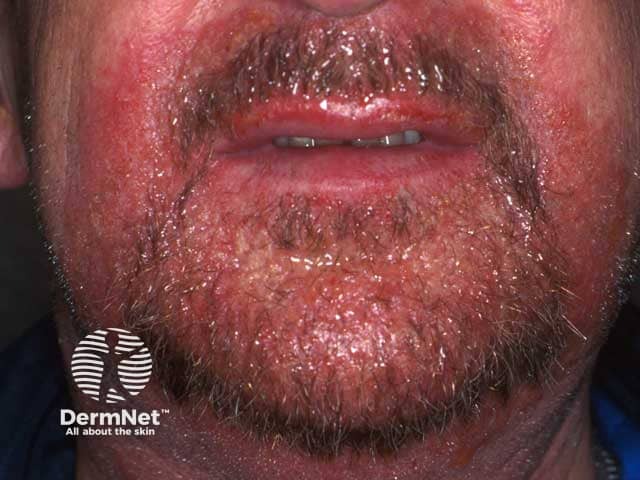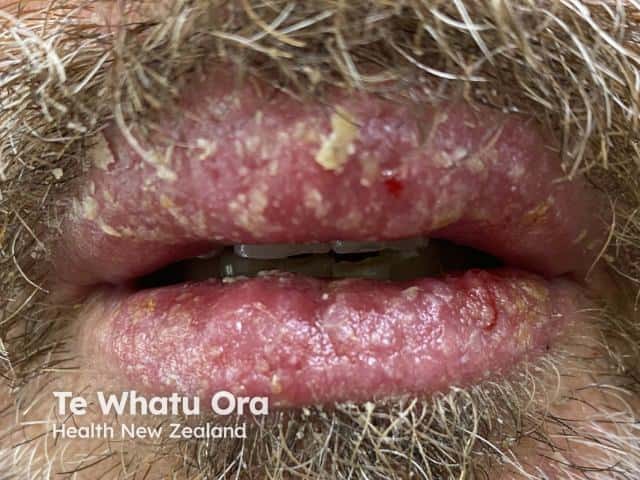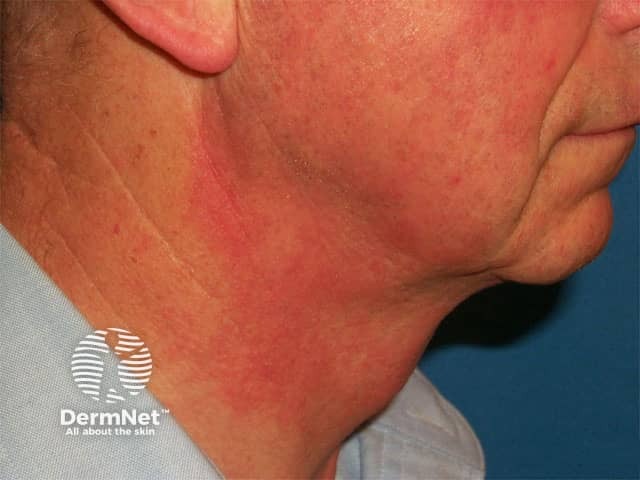Main menu
Common skin conditions

NEWS
Join DermNet PRO
Read more
Quick links
Authors: Vanessa Ngan (2012); Tu-An Ma, University of Adelaide, Australia (2023)
Reviewing dermatologist: Dr Ian Coulson
Edited by the DermNet content department
Introduction
Cosmetics standard authorities
Demographics
Causes
Clinical features
Variation in skin types
Complications
Diagnosis
Differential diagnoses
Treatment
Prevention
Outcome
A cosmetic is a topical product designed to improve the odour, appearance, or cleanliness of an external body part.
Examples of cosmetics include:
Although cosmetics and therapeutic agents (drugs) classification vary around the world, it can generally be based on their designed intention; cosmetic or therapeutic.
Many products have both cosmetic and therapeutic functions. For example:
Cosmetic injectables such as botulinum toxin can also have cosmetic uses (eg, smoothing out lines and wrinkles) and therapeutic indications (eg, hyperhidrosis).

Acute weepy facial eczema due to beard dye allergy

Eczema of the lips due to propyl gallate allergy in a lip salve

Allergic contact dermatitis due to perfume in aftershave
Regulatory standards ensure cosmetic products are safe for handling, the environment, and use by consumers. These include:
Contact reactions to cosmetics are common. It is estimated that the average adult uses 6–12 cosmetic products daily. Pooled data from several studies in Europe and the United States found a prevalence of ~10% of cosmetic allergy in patients undergoing patch testing. Underreporting of cosmetic reactions is likely as many reactions are mild and self-limiting, and often self-managed. In one study in the United Kingdom, 57% of women and 31% of men self-reported having ever had an adverse reaction to a cosmetic product; 23% of women and 14% of men self-reported this had occurred within the preceding year (Willis et al, 2001).
Some people may develop more than one type of contact skin reaction. For example, an atopic individual may be prone to irritant contact dermatitis, which in turn increases their likelihood of allergic contact dermatitis, as their skin barrier function is weakened and sensitised to the allergen.
It is possible for a cosmetic allergy to develop even after years of using a cosmetic without previous problems.
Any constituent of a cosmetic has the potential to cause a contact reaction. Ingredients that appear to most frequently cause cosmetic reactions are fragrances, preservatives, and paraphenylenediamine (PPD) (found in many hair dyes).
Other irritants/allergens used in cosmetics include:
Cosmetics can produce a range of adverse reactions. Different products can result in different reaction patterns. For example, cheilitis can be caused by lip care products, while lateral facial dermatitis is often consistent with a reaction to a ‘rinse off’ product such as a shampoo or conditioner that runs down over the sides of the face and neck.
Erythema may be less evident in darker skin types, and postinflammatory hyperpigmentation is more common.
Cosmetic allergy is diagnosed through patch testing. A diagnosis may be made through testing against various possible allergens. Some allergens that may be found in cosmetics are present in baseline series of patch test allergens, and a specific Cosmetics Series has also been developed. See individual contact allergens for patch-testing recommendations.
A repeat open application test may also be recommended, and repeated open application tests may be useful when patch tests continue to produce negative results. The cosmetic is applied twice a day for 10 days to the same site (often on the inner forearm) and any reaction noted.
Most contact reactions to cosmetics are mild and will improve after the allergen source is identified and avoided. Irritant contact dermatitis is more common than allergic contact dermatitis. Prolonged symptoms or the symptoms of anaphylaxis (eg, angioedema and airway swelling) should be reviewed promptly by a clinician.